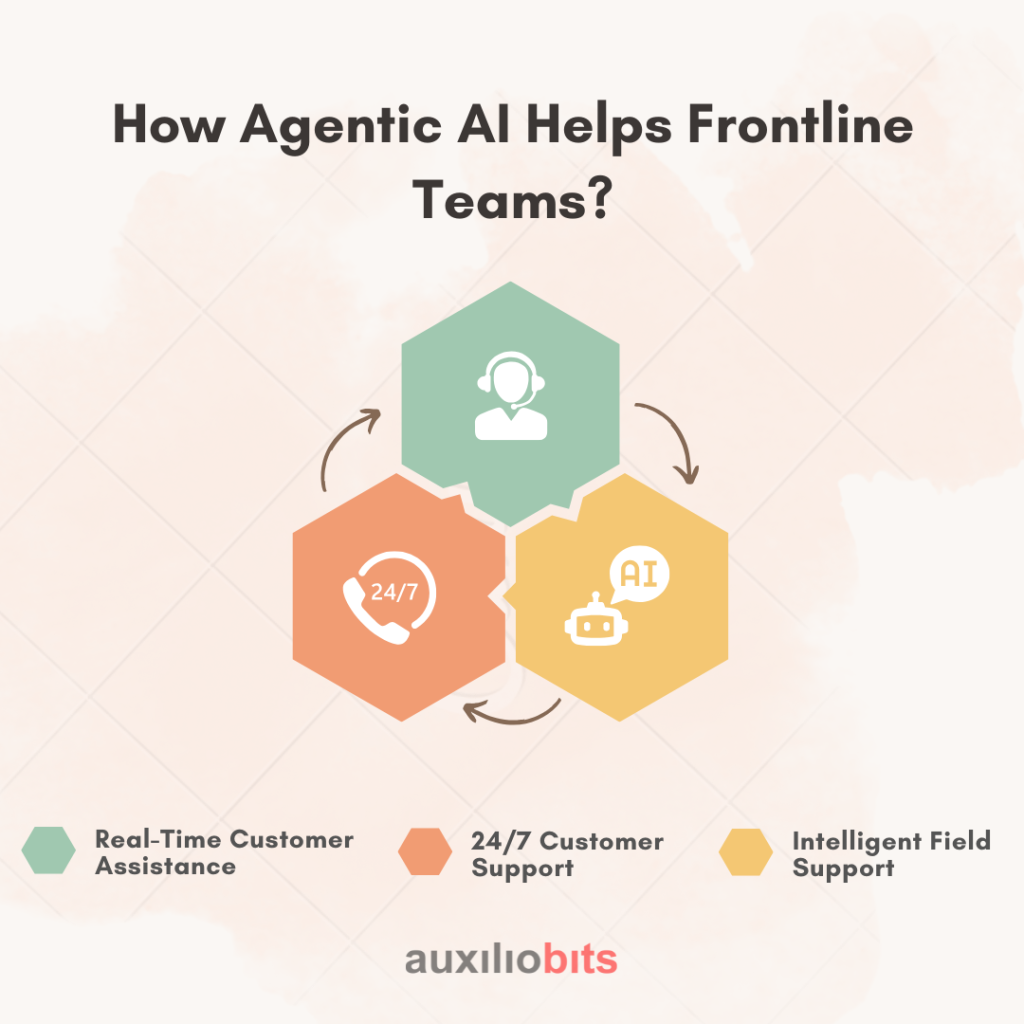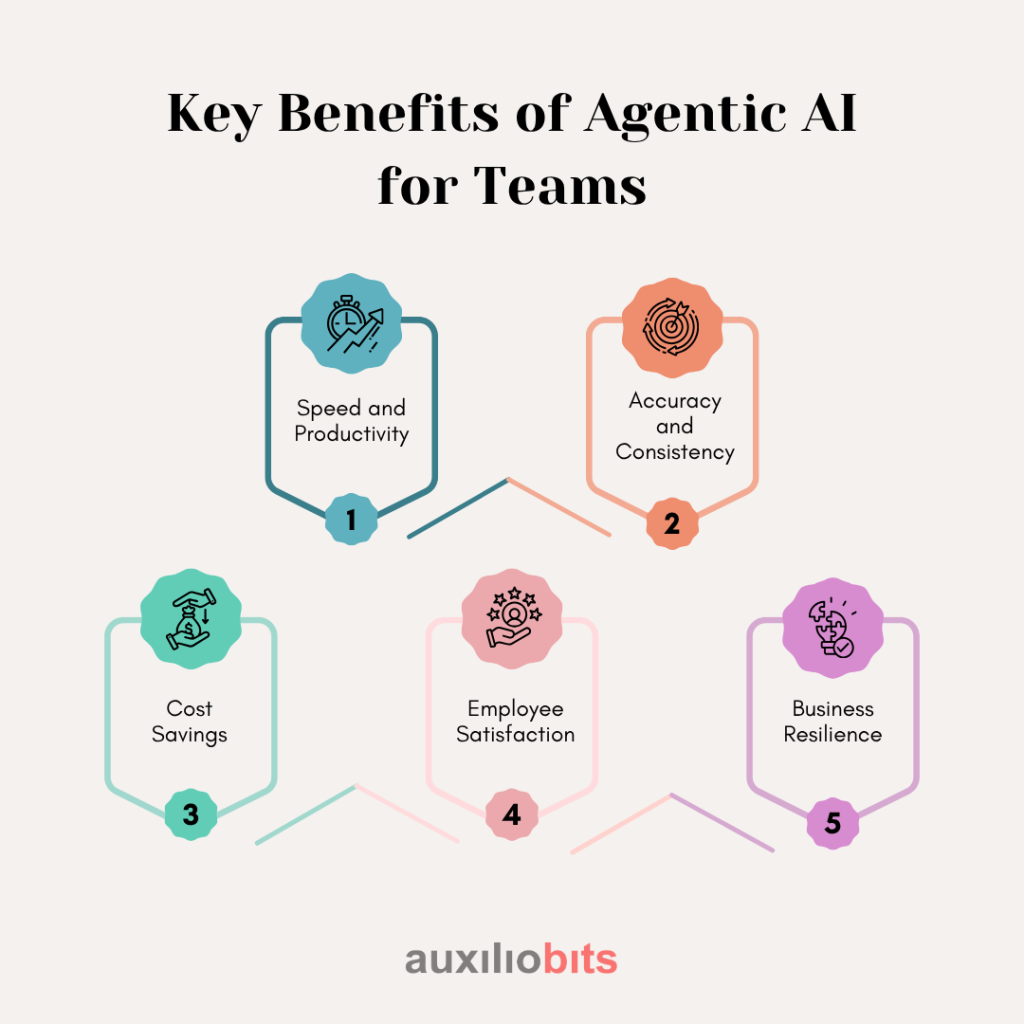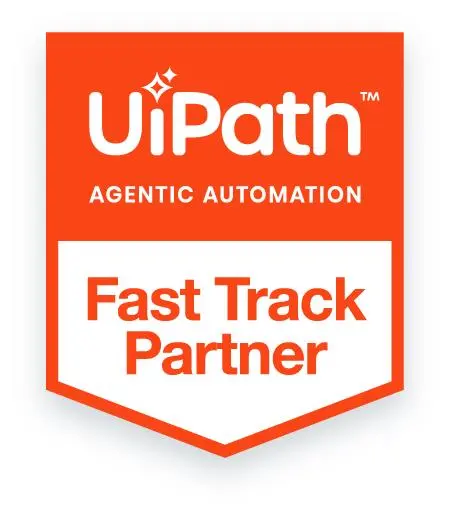
Key Takeaways
- Agentic AI empowers frontline and back-office teams by automating complex tasks, providing real-time support, and adapting to dynamic environments, ultimately improving productivity and decision-making.
- Agentic AI supports frontline teams by offering real-time customer assistance, automating common queries, and suggesting personalized responses, which results in faster issue resolution and improved customer satisfaction.
- Agentic AI benefits back-office functions like finance, HR, and document processing. This technology automates document-heavy workflows, improves accuracy, and streamlines operations, allowing teams to focus on strategic tasks.
- By handling repetitive tasks, Agentic AI increases operational speed, enhances accuracy, reduces human error, and generates significant cost savings, optimizing resource utilization and boosting ROI.
- Agentic AI augments human potential by taking over routine tasks, allowing employees to focus on higher-value work, fostering job satisfaction, reducing burnout, and promoting innovation and creativity.
In today’s competitive business environment, organizations face constant pressure to move faster, serve customers better, and make smarter decisions. To keep up, many companies are now embracing Agentic AI—a powerful evolution of artificial intelligence in which autonomous agents work alongside humans to handle tasks, solve problems, and continuously adapt in real time.
But what exactly is Agentic AI?
At its core, agentic AI involves intelligent software agents beyond traditional automation. These agents can understand goals, make decisions, execute tasks independently, learn from experiences, and collaborate with humans and other agents. They aren’t just reactive bots that follow rigid rules. Instead, they are proactive, context-aware, and goal-driven—capable of functioning with minimal human oversight.
Imagine having a digital coworker who can read emails, extract information, make decisions based on business logic, communicate with systems or people, and adjust its behavior based on real-time changes. That’s what Agentic AI offers.
This means faster customer support, intelligent request routing, and personalized service delivery for frontline teams. For back-office operations, it means streamlined processes like invoice handling, compliance checks, data reconciliation, and reporting—handled by AI agents that can adapt and learn over time.
What makes Agentic AI revolutionary is its autonomy and adaptability. These agents are designed to operate in dynamic environments, making them ideal for modern enterprises that need to scale quickly and stay agile.
Also read: Computer Vision Applications in Diagnostic Imaging: Current State and Future Directions.
Why Agentic AI Matters for Businesses?
Before the emergence of Agentic AI, most business automation efforts relied on tools like Robotic Process Automation (RPA). These tools were designed to handle rule-based, repetitive tasks, such as data entry, invoice processing, or system updates, by mimicking human actions across digital systems. While RPA significantly improved efficiency and reduced manual labor, it had apparent limitations.
Traditional bots often lacked flexibility. If a process changed slightly—a website’s layout was updated or a new field was added in a form—the automation would break, requiring manual intervention and reprogramming. These systems weren’t built to handle exceptions or respond dynamically to new conditions. As a result, their value was mostly confined to structured, predictable workflows.
This is where Agentic AI represents a significant leap forward.
Unlike RPA bots, Agentic AI systems consist of intelligent agents that can understand context, make decisions, and act independently. They don’t just follow rules—they analyze situations, prioritize goals, adjust to changing conditions, and even learn from past experiences. These agents can handle more complex and dynamic business scenarios, reducing the burden on human teams and minimizing disruption when things change.
For frontline teams, Agentic AI means smarter, real-time support. Agents can assist in customer interactions, personalize responses, escalate issues intelligently, or even resolve queries autonomously. This leads to faster response times, greater customer satisfaction, and better resource utilization.
Agentic AI transforms processes like document classification, fraud detection, and regulatory compliance for back-office operations. Agents can collaborate, distribute workloads, and self-correct, enabling scalable and resilient workflows that evolve with the business.
Perhaps most importantly, Agentic AI unlocks true agility. In an era where businesses must rapidly respond to market shifts, customer needs, and emerging technologies, having AI agents that can adapt on the fly offers a significant strategic advantage
How Agentic AI Helps Frontline Teams?
Frontline teams are the face of any organization. They include call center agents, retail staff, delivery drivers, field service technicians, and healthcare workers who directly engage with customers, often in real-time and high-pressure environments. Their effectiveness directly influences customer satisfaction, loyalty, and business outcomes. However, they face challenges like information overload, inconsistent processes, and limited real-time support.
Agentic AI addresses these challenges by providing intelligent, autonomous agents that collaborating with human workers to streamline operations, boost productivity, and enhance customer experience. Let’s explore the key benefits and use cases further.

1. Real-Time Customer Assistance
Agentic AI is a real-time co-pilot for frontline staff in dynamic customer interactions, like live calls or chat sessions. It listens or reads along with the conversation, understands the customer’s intent using Natural Language Understanding (NLU), and instantly assists the human agent with the correct information or next step.
Some of the ways it helps include
- Suggesting accurate responses based on context and historical data
- Fetching account details, order history, or product info from connected systems
- Triggering backend processes, such as raising a support ticket or initiating a refund
- Recommending personalized solutions, such as upsell offers or troubleshooting tips
Example: In a customer support center, while a human agent speaks to a customer, the AI agent fetches relevant case history, displays step-by-step guidance, and even drafts the following response, freeing the agent to focus on empathy and customer rapport.
2. 24/7 Customer Support
Agentic AI can fully automate frontline support outside business hours, eliminating wait times and improving availability. Unlike static chatbots, AI agents adapt to evolving language, learn from feedback, and handle nuanced queries with greater flexibility.
Capabilities include:
- Understanding and resolving common requests, like password resets, shipping status, or appointment booking
- Escalating only complex or sensitive issues to human teams during working hours
- Personalizing answers using historical customer data
- Continuously learning from new interactions to expand its coverage.
Example: A telecom company uses an AI agent to respond to after-hours queries via WhatsApp and voice. Customers ask about billing, data plans, or outages, and the AI agent responds instantly, resolving 80% of requests without human help.
3. Intelligent Field Support
Field employees often face unpredictable situations, such as malfunctioning equipment, incorrect deliveries, or unfamiliar scenarios. Agentic AI provides mobile, on-demand support, allowing them to work smarter and faster.
AI agents can:
- Access manuals, SOPs, or FAQs via voice or text queries
- Computer vision can identify machinery, parts, or defects from camera input.
- Log incidents or service reports automatically and suggest the following actions.
- Trigger backend workflows like spare part ordering, technician dispatch, or customer notifications
Example: A technician in the field encounters a faulty HVAC unit. They scan the unit with their phone. The AI agent identifies the model, analyzes the issue based on historical data, checks for spare part availability, and initiates a replacement order without a call to support.
How Agentic AI Supports Back-Office Teams?
Back-office teams—spanning functions like finance, HR, legal, IT, and operations—form an organization’s operational backbone. Their work is essential but often burdened by high volumes of data, repetitive workflows, and compliance-heavy processes. Traditional automation has helped to some extent, but it’s usually rigid, brittle, and unable to deal with edge cases or judgment-heavy tasks.
Agentic AI transforms this landscape by introducing intelligent agents that can reason, adapt, and collaborate across systems. This frees humans from routine and enables strategic focus.
1. Automating Document-Heavy Workflows
One of the most time-consuming challenges for back-office teams is dealing with large volumes of documents. From invoices to legal contracts, traditional data extraction tools often fail with unstructured formats, varied layouts, or missing information.
Agentic AI excels in these scenarios by combining Natural Language Processing (NLP), Computer Vision, and reasoning capabilities. It reads and extracts relevant data, understands context, compares values across systems, and flags inconsistencies.
Example: In mortgage underwriting, AI agents can autonomously process 50+ page applications—extracting income, liabilities, and employment history from pay stubs and tax forms, validating them across multiple databases, and highlighting exceptions for human review. This can reduce processing time from several days to under an hour.
2. Financial Operations and Forecasting
Finance teams must ensure accuracy, detect anomalies, and deliver fast, data-driven insights. Traditional methods involve manual reconciliations, time-consuming Excel modeling, and reactive fraud checks.
Agentic AI brings intelligence and automation together to:
- Reconcile thousands of transactions automatically
- Monitor real-time spending patterns.
- Generate predictive cash flow models.
- Detect anomalies or fraud by learning from past patterns.
Example: A finance AI agent continuously analyzes bank feeds, ERP data, and expense reports. It flags suspicious transactions, categorizes spending by department, and provides CFOs with daily predictive cash flow dashboards—freeing analysts to focus on planning and strategy.
3. HR and Recruitment Automation
Human Resources functions are often overwhelmed by administrative tasks, especially recruiting and onboarding. Agentic AI helps streamline and elevate the HR function by automating:
- Resume parsing and shortlisting based on role fit
- Interview scheduling with calendar integration
- Employee onboarding workflows, like document collection and provisioning
- FAQ answering on policies, benefits, or procedures
Example: An AI agent scans hundreds of job applications, ranks candidates based on skill fit, books interviews with hiring managers, and even answers queries like “What’s the leave policy?” via a chatbot, allowing HR to focus on culture, engagement, and retention.
By handling the repetitive, context-heavy, and time-sensitive tasks that dominate back-office operations, Agentic AI boosts accuracy, reduces turnaround times, and enhances decision-making, ultimately helping businesses run smoother and brighter.
Key Benefits of Agentic AI for Teams
As businesses strive for agility, efficiency, and innovation, Agentic AI emerges as a transformative force for frontline and back-office teams. Unlike traditional automation, which handles narrowly defined, repetitive tasks, Agentic AI introduces adaptive, goal-oriented agents that can perceive context, make autonomous decisions, and collaborate with humans in real time.
Below are five key benefits that illustrate why Agentic AI is becoming critical for modern enterprises:

1. Speed and Productivity
Agentic AI dramatically increases operational speed by automating tasks that once consumed hours or days. Whether processing customer queries, reviewing legal contracts, or reconciling financial transactions, AI agents can work 24/7 without breaks, delivering results instantly.
For frontline teams, this means faster customer service and issue resolution. In contact centers, AI agents can handle call summaries, auto-fill CRMs, or assist with knowledge lookups while the agent talks, significantly reducing average handling time.
For back-office teams, this means automated document processing, approvals, or data validation, allowing staff to focus on value-added tasks. This acceleration results in faster service delivery, reduced backlog, and quicker turnaround times across departments.
2. Accuracy and Consistency
Human error is an unavoidable reality in high-volume or high-pressure work environments. Mistakes in data entry, document handling, or customer service scripts can result in poor customer experience or compliance risks.
Agentic AI improves outcomes by ensuring consistent rule application, accurate data handling, and reduced manual oversight errors. These agents can cross-verify information across systems, follow complex decision trees, and ensure business rules and regulations compliance.
For example, in finance or healthcare, AI agents can flag discrepancies between documents, detect compliance gaps, or identify fraud patterns with greater accuracy than human-only teams.
3. Cost Savings
By reducing reliance on manual labor for routine work, Agentic AI enables businesses to achieve more with fewer resources. The cost savings come not just from automation itself, but from the avoidance of rework, error correction, and downtime.
Instead of hiring additional headcount during seasonal peaks or to manage operational scale, companies can deploy AI agents that adapt dynamically, scaling up during demand spikes and scaling down in quieter periods.
This leads to more predictable operational costs, improved ROI on AI investments, and overall better financial performance for the organization.
4. Employee Satisfaction
Agentic AI isn’t about replacing humans—it’s about augmenting them. When AI agents take over monotonous or high-stress tasks like document routing, ticket categorization, or manual lookups, employees can focus on strategy, innovation, and human-centric problem-solving.
This shift reduces burnout and improves morale. Employees feel more engaged and valued when they’re not stuck in repetitive loops and can contribute to meaningful outcomes.
For instance, a customer support agent can focus on empathy and complex queries, while the AI handles background workflows, creating a better experience for both employee and customer.
5. Business Resilience
Resilience is key in today’s uncertain business environment, marked by global disruptions, labor shortages, and shifting market demands. Agentic AI helps organizations become more agile and responsive.
AI agents don’t get sick, take leave, or burn out. They continue working through holidays, crises, or emergencies. They can adapt to new rules, emerging situations, or updated systems in real time.
This always-on, self-learning capability enhances business continuity and ensures companies can maintain service levels even when human resources are stretched thin.
The Human + AI Collaboration: Elevating Work, Not Replacing It
A common fear in the conversation about automation and AI is, will machines take our jobs? But Agentic AI redefines this narrative. It is not about replacing humans but enhancing human potential through collaboration.
Agentic AI introduces intelligent agents capable of handling routine, repetitive, and data-heavy tasks. However, these agents are not designed to operate in isolation. Instead, they work alongside people, acting as digital teammates that empower workers to be more strategic, creative, and fulfilled.
Augmenting, Not Replacing
Think of Agentic AI as a copilot in the workplace. It takes on tedious, time-consuming, or error-prone tasks, such as pulling data from documents, initiating follow-ups, or cross-referencing information. This allows human employees to focus on what they do best: solving complex problems, making informed decisions, showing empathy in customer service, and driving innovation.
- In HR, AI can screen resumes, but a human still interviews and evaluates cultural fit.
AI can summarize patient history in healthcare, but a doctor still makes diagnoses and treatment choices. - In customer support, AI can suggest answers, but humans bring warmth, humor, and emotional intelligence.
This division of labor doesn’t eliminate roles—it elevates them.
Final Thoughts
Agentic AI is not science fiction—it’s already transforming how teams work. From helping customer service reps respond faster to enabling finance teams to close the books in hours, AI agents are driving real value across organizations.
By blending autonomy, intelligence, and collaboration, Agentic AI is becoming the invisible teammate every business needs—quietly improving performance, reducing stress, and delivering better outcomes for customers and employees.
The future of work is here—and it’s Agentic.








